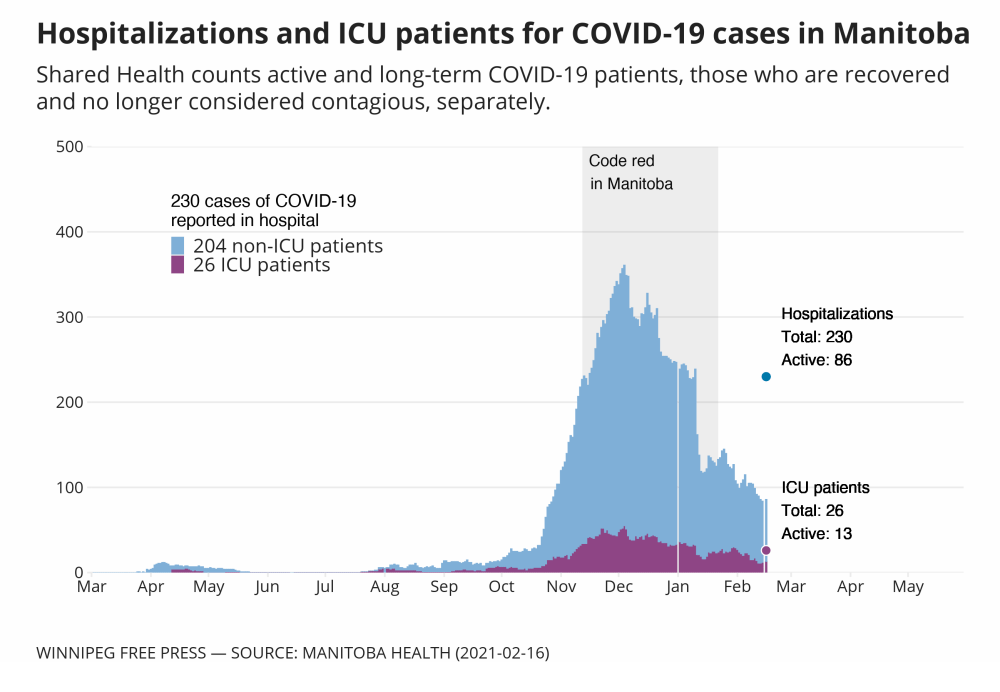Manitoba obligated to further loosen restrictions if hospitalizations remain low
Read this article for free:
or
Already have an account? Log in here »
To continue reading, please subscribe:
Monthly Digital Subscription
$0 for the first 4 weeks*
- Enjoy unlimited reading on winnipegfreepress.com
- Read the E-Edition, our digital replica newspaper
- Access News Break, our award-winning app
- Play interactive puzzles
*No charge for 4 weeks then price increases to the regular rate of $19.00 plus GST every four weeks. Offer available to new and qualified returning subscribers only. Cancel any time.
Monthly Digital Subscription
$4.75/week*
- Enjoy unlimited reading on winnipegfreepress.com
- Read the E-Edition, our digital replica newspaper
- Access News Break, our award-winning app
- Play interactive puzzles
*Billed as $19 plus GST every four weeks. Cancel any time.
To continue reading, please subscribe:
Add Free Press access to your Brandon Sun subscription for only an additional
$1 for the first 4 weeks*
*Your next subscription payment will increase by $1.00 and you will be charged $16.99 plus GST for four weeks. After four weeks, your payment will increase to $23.99 plus GST every four weeks.
Read unlimited articles for free today:
or
Already have an account? Log in here »
Hey there, time traveller!
This article was published 16/02/2021 (1761 days ago), so information in it may no longer be current.
The number of COVID-19 patients in Manitoba hospitals is dropping again. That’s good news, especially when it comes to reopening the economy.
If that trend continues and infection rates keep falling (or even remain stable), there’s a good a chance the province could loosen its pandemic restrictions further by early March.
There are qualifiers, though.
Widespread transmission of new, highly infectious variants — such as the B.1.1.7 variant first detected in the United Kingdom — would likely delay reopening plans. (So far, only one such case has been confirmed in Manitoba).
Multiple outbreaks in congregate settings, such as long-term care facilities, would also be reason for pause; as would widespread transmission in public schools.
Barring any of those, there’s every reason to believe restrictions could be loosened as early as March 5 (when existing public health orders expire), if case numbers and hospitalizations continue to fall.
Protecting hospital capacity is one of the main goals of the province’s pandemic response plan. Next to mitigating death, it is the main objective. Code-red restrictions were implemented in November mainly because hospitals and intensive care units were operating well above capacity. People were at risk of being denied basic care.
Admissions started to come down in December and hospitalizations continued to fall throughout January.
They plateaued during the first 10 days of this month (peaking at 271 on Feb. 8).
Since then, there’s been a steady decline. On Tuesday, there were 230 COVID-19 patients in hospital (86 active and 144 recovered) and 26 in ICU. That’s down from 339 hospitalizations, including 41 in ICU, on Jan. 3.
Dr. Brent Roussin, Manitoba’s chief provincial public health officer, said Tuesday if case numbers and hospitalizations continue to trend in that direction, Manitoba should be able to continue its reopening plan. He said numbers are expected to fall further under the current orders as long as people continue to comply with the rules.
What the numbers show is most Manitobans have learned to live with COVID-19. People are largely following the regulations; at least enough of them are to make a difference.
It has been over three weeks since restrictions were first eased Jan. 23, which included limited socializing between households (the designated two-person rule) and the reopening of most retail. Since then, case numbers have fallen and Manitoba’s test positivity rate has dropped by nearly half, to 5.9 per cent.
It’s still too early to know the impact of the latest changes, which came into effect Feb. 12. That won’t be known for at least another week.
The reopening of restaurants and lounges (which were part of those changes) was risky, even if it is limited to household members. However, the timing was right and it will test whether Manitobans truly have learned to live with COVID-19.
What the numbers show is most Manitobans have learned to live with COVID-19. People are largely following the regulations; at least enough of them are to make a difference.
If case numbers and hospitalizations continue to fall over the next two weeks, the province would have an obligation to loosen restrictions further. The changes would likely be modest; the last thing anyone wants — including businesses — is a spike in cases and hospitalizations that lead to more shutdowns. The reopening has to be incremental.
Many businesses and not-for-profit groups are on the verge of bankruptcy; some have already gone under. Economically, small businesses have sacrificed the most during the pandemic (many have still not been adequately compensated). Every step to reopen the economy, no matter how small, will help.
That could mean increasing capacity to 50 per cent for restaurants and retail (from the current 25 per cent). For some, it might make the difference between staying afloat or closing down for good.
No single metric will dictate what changes, if any, will be made to public health orders March 5. However, the fact hospitalization numbers are coming down again and fewer patients are being admitted to ICU is a critical consideration. Without those improvements, the province would be hard pressed to loosen any restrictions at all.
tom.brodbeck@freepress.mb.ca

Tom has been covering Manitoba politics since the early 1990s and joined the Winnipeg Free Press news team in 2019.
Our newsroom depends on a growing audience of readers to power our journalism. If you are not a paid reader, please consider becoming a subscriber.
Our newsroom depends on its audience of readers to power our journalism. Thank you for your support.








